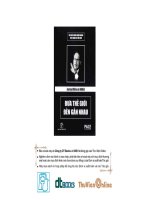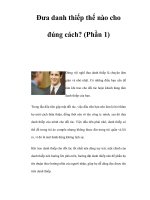learn the Principles of Business Writing PHẦN 1 ppt
Bạn đang xem bản rút gọn của tài liệu. Xem và tải ngay bản đầy đủ của tài liệu tại đây (1.15 MB, 10 trang )
Capture. Deliver. Excel.
Applying the Principles of Business Writing
Ilja van Roon / Lucid Communication
© 2006 Ilja van Roon/Lucid Communication
All rights reserved
including the right of reproduction
in whole or in part in any form
This book can be downloaded for free at www.capturedeliverexcel.com.
Written and edited by Ilja van Roon, Lucid Communication (www.lucidcommunication.nl)
Proofread by Mark Biss, WordsRU (www.wordsru.com)
Designed by Made of Man visual identity (www.madeofman.nl)
Lucid Communication
Paulinastraat 78
2595 GK The Hague
The Netherlands
www.lucidcommunication.nl
Acknowledgements 5
Introduction 7
Overview of the principles of business writing 11
The first principle: focus 13
The second principle: purpose 27
The third principle: meaning 39
The fourth principle: substance 47
The fifth principle: structure 53
The sixth principle: clarity 63
The seventh principle: humility 71
The writing process from start to finish 75
About the author 90
About the designers 91
Table of contents
Having grown up in a multicultural and multilingual environment, language has always
been the best way for me to make sense of myself and the world. I love the raw po-
wer, elegance and versatility of language, and not a day goes by in which I don’t play
or work with words. Looking back, it seems only natural that my passion has become
my profession.
To me, writing is a natural process that is inherently intuitive. I visualise, go by my gut
feeling and listen to the sonic quality of language. With these resources at my disposal
- and a decade of professional writing experience - the writing sometimes seems to
happen by itself. But my way of working has an underlying structure that, I realised,
I could try to teach others.
This book was born of the desire to identify that underlying structure. While this
seemed like a pretty straightforward task, I have to confess it has been frustrating and
challenging. I am sure, that like me, you will appreciate the irony of a professional wri-
ter having difficulty writing about his writing. Luckily for me, I found friends, relatives
and clients willing to help me see this project through. They challenged my ideas and
gave me constructive feedback on anything from style to structure.
For this, I want to express deep gratitude to Julia Balandina at American International
Group; Lindsay Bogaard at Bogaard Arena; Thijs Westerkamp, Ronald Meijers and Steffi
Gande at Krauthammer International; Heidi Does at TNT Logistics, Annedien Hoen at
Annedienhoen.nl, Lucy Lambriex at Lab Lambriex, Cindy van Roon at Lexbridge, Branka
van Roon at The Excellent Leadership Company, Marjolijn Dijksterhuis at Mea, Tari
Habbitt and Dennis Larsen at ReputationInc and Iben Molenkamp.
Special thanks goes out to Rob Leenders and his team at Made of Man, who used their
talents to design a compelling visual counterpart to my book. Rob and I met at the
Masters in Corporate Communication programme at RSM Erasmus University, which
allowed us to combine design and language in strategic business communication.
5 c a p t u r e . d e l i v er . e x ce l . a c kno w led g eme n ts
Introduction
Consider the vast amount of text that your organisation produces. Picture the sea of
memos and the stack of reports you receive on an annual basis. Or think of the count-
less e-mails, presentations and plans you write for your colleagues. Business writing,
the process by which such texts are created, is a pervasive activity within any organi-
sation.
This internal dialogue - much like the human brain that spends most of its energy tal-
king to itself - has tremendous impact on your organisation’s ability to compete. Good
business writing captures knowledge, aligns people with the organisation’s strategy,
and catalyses organisational change. It can also be a superb tool for corporate commu-
nication and sales purposes.
In my experience, there are two reasons why organisations do not make optimal use
of business writing. First of all, most aren’t adjusting quickly enough to the fact that
stakeholders are becoming fed up with spin doctoring and corporate doublespeak.
Employees, customers and investors are increasingly demanding clear communication
and organisations unable to comply run the risk of alienating these crucial allies.
A second obstacle is that few employees are trained to write about the complex issues
that characterise business. Writing is not an arcane form of art, but a skill like leader-
ship that matures with training and experience. Writing talent helps, but good writing
is essentially built on thorough preparation and disciplined execution. This means that
anyone can learn to write at a reasonable level of proficiency.
This book aims to improve your writing skills by teaching you how to use the principles
of business writing. These principles - focus, purpose, meaning, substance, structure,
clarity and humility - have been derived from my work as a journalist, copywriter,
corporate communication specialist and business writer. They reflect my experience of
what works and my personal views of how business writing should be used within the
organisation.
The book combines a conceptual approach with a practical one to help you more fully
integrate what you will learn into your daily work. The principles - specifically what
they mean and how they can be applied - are discussed individually and presented as
a coherent model that mirrors issues facing modern organisations. The book also sug-
gests how to apply the principles to day-to-day business topics, and explains how to
manage the writing process from beginning to end.
You can use the principles in this book to communicate about leadership, change,
culture and other strategic business issues. The principles will allow you to create a
sense of shared purpose among stakeholders and capture valuable knowledge. The
book also teaches writing strategies that you can apply to anything from simple
memos to complex proposals. Mastery of this system will make you self-reliant, more
insightful and more effective when it comes to business writing.
Language is a powerful kind of magic. This book is an attempt to identify its underlying
structure in the context of business and present it in a way that is easy to understand.
It is by no means definitive or without fault, even though I have done my utmost to
apply these principles to the book itself. Whatever you think of the principles, I hope
you will find in them something that helps you write better than you have written
before.
Ilja van Roon
April 2006
Meaning
Humility
Clarity
Focus
Meaning
Purpose
Structure
Text
Substance
10 w w w . c a pt u r e d e l i v e r e x c e l . c o m









